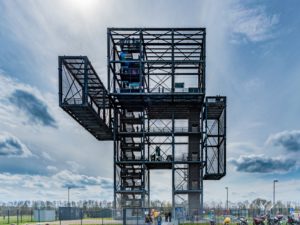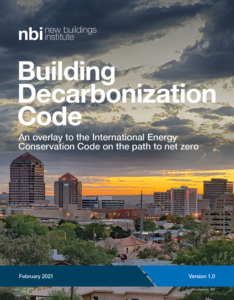With buildings currently representing 39% of U.S. carbon emissions from operational and embodied sources, jurisdictions look toward advanced building codes and policies as critical and urgent strategies for meeting their climate goals. Despite overwhelming support from public bodies, recent efforts to create climate-aligned codes, or codes that address resilience, energy efficiency and carbon emissions, have been thwarted.
We expect more jurisdictions to join the 25 states and more than 470 mayors who remain committed to the Paris Climate Agreement. To rise to this challenge, New Buildings Institute (NBI) has partnered with RMI to launch Codes for Climate™, an initiative offering achievable pathways for cities and states to accelerate the development, adoption and implementation of codes, standards and policies that aim to keep temperature rise under 1.5°-degrees Celsius.
Creating new alignment with the national model codes
National model energy codes are updated every three years and direct how new construction—both residential and commercial buildings—are designed and built to meet a minimum energy performance. Since the inception of energy codes over 45 years ago, policies have centered on saving kilowatt-hours of electricity, therms of natural gas and/or dollars off utility bills. Advances in the most recent three-year code cycle update have delivered energy savings—and resulting emissions reductions—of approximately 9% for residential in the International Energy Conservation Code (IECC) and 4.7 % for commercial in ASHRAE 90.1.
Yet, despite the urgent need to address carbon and other greenhouse gas emissions (GHG) reductions alongside energy savings, there is a continued misalignment between energy codes and their potential to help jurisdictions meet climate goals. In order to keep temperature rise under 1.5°-degrees Celsius, it’s critical we take action in the next cycle to align our codes.
In order to keep temperature rise under 1.5°-degrees Celsius, it’s critical we take action in the next cycle to align our codes.
 In March, the International Code Council (ICC) made a controversial change to the way it develops and approves its model energy code. It moved from a structure of open voting of governmental members to a board-appointed committee, as part of the new process outlined within the council’s energy efficiency and GHG reduction framework. The board of directors recently appointed 48 members to its Residential Energy Code Consensus Committee and 45 members to its Commercial Energy Code Consensus Committee. NBI was honored to learn that our own Mark Lyles and Diana Burk were appointed to serve on the committees, respectively.
In March, the International Code Council (ICC) made a controversial change to the way it develops and approves its model energy code. It moved from a structure of open voting of governmental members to a board-appointed committee, as part of the new process outlined within the council’s energy efficiency and GHG reduction framework. The board of directors recently appointed 48 members to its Residential Energy Code Consensus Committee and 45 members to its Commercial Energy Code Consensus Committee. NBI was honored to learn that our own Mark Lyles and Diana Burk were appointed to serve on the committees, respectively.
With interest in building decarbonization on the rise across the U.S., ASHRAE recently established the Building Decarbonization Position Document Committee to develop a formal statement on the issue. Jim Edelson has been appointed to the committee, which will play a critical role in helping ASHRAE leadership and members understand and articulate a position for how building decarbonization legislation and regulations should impact the industry over the next 10 to 30 years.
ASHRAE also established a Task Force for Building Decarbonization to develop technical resources and provide leadership and guidance around the development of resilience—and climate—focused building codes. More than 100 people have been assigned to the task force’s working groups. I’ll be serving alongside NBI board member Bing Liu, chair of the Building Performance Standards (BPS) working group, to develop a comprehensive guide to successfully implement a BPS and other important technical aspects of BPS. I’m joined by NBI’s Webly Bowles, who is serving on the Embodied Carbon / Life Cycle Assessment working group.

Providing climate aligned codes and policies
Code and standard development remains a consensus-driven process that may not provide solutions as fast as we need them. Using NBI’s recently released Building Decarbonization Code as a starting point, Codes for Climate will develop code language to ensure building codes help cities and states avoid a temperature increase above 1.5°-degrees Celsius by 2030. Alternative code language will be released, starting with new construction, where ambitious climate-aligned codes are easiest and cost the least to implement and expanding to include the code as a tool to impact existing buildings.
Next, we’ll work with jurisdictions on BPS and other policy options that will dramatically reduce emissions from existing buildings—on a 2030-2050 timeline.
Supporting policymakers to meet goals of climate, resilience, and equity
NBI and RMI regularly work with leading jurisdictions—especially those who want to push beyond the current model codes—as they prepare for code cycle updates and explore policy options. We will guide cities and states through the process of adopting more stringent codes starting today, meeting the need of the moment with code and policy models for buildings that drive the necessary response to the climate crisis we face.
While actions of special interest groups have historically flattened progress, this initiative could bring a much needed sea change to our code-making process. If all U.S. jurisdictions with climate goals participate in the Codes for Climate initiative, we could collectively accomplish half the established buildings-sector climate goals.
by Kim Cheslak, Director of Codes
Bio
Did you enjoy this content? Consider supporting NBI’s work with a donation today.
